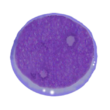The flow cytometric diagnosis of AML: Difference between revisions
From haematologyetc.co.uk
No edit summary |
No edit summary |
||
| Line 47: | Line 47: | ||
'''NOTE''' In cases | '''NOTE''' In some cases an extended marker panel may allow the pattern of differentiation to be identified (e.g. erythroid or megakarocytic). In difficult cases these markers may provide additional evidence of myeloid lineage (although their specificity is often less than the general myeloid-associated markers so care is required when using them in this way). </br> | ||
[[Additional immunophenotypic markers useful in lineage assignment or subtyping of AML|Click for table of extended marker set for AML immunophenotype]] | [[Additional immunophenotypic markers useful in lineage assignment or subtyping of AML|Click for table of extended marker set for AML immunophenotype]] | ||
Revision as of 14:18, 23 December 2023
| 1. Can you demonstrate the primitive nature of the blast cells? |

The typical "primitive" morphology of blast cells is generally accompanied by signs of primitive immunophenotype
- in most cases AML will demonstrate typical features of immature cells with: weak expression of CD45, and expression of CD34 and/or CD117. In difficult cases other markers may help (see Click for more detailed description)
- NOTE In cases where blast cells show differentiation to more mature forms their primitive nature may be less clear. This is most frequently encountered in monocytic cases of AML, or in acute promyelocytic leukaemia (APL) (Click for a more detailed description)
| 2. Can you assign myeloid lineage? |

Like Auer rods or granulation in morphology, particular immunophenotypic features support assignment to myeloid lineage
The criteria to assign myeloid lineage in AML have been established by the WHO, two alternative sets of criteria may be used (although most cases will meet both):
| Criteria Set 1: |
|---|
| A myeloid lineage-defining marker pattern is present and no lineage-defining markers of T or B cells are present (Click for detailed description) |
| Criteria Set 2: |
| At least two myeloid lineage-associated markers are present and there are no lineage defining markers of T or B cells and no more than one: T-cell or B-cell lineage-associated marker is present (Click for detailed description) |
NOTE In some cases an extended marker panel may allow the pattern of differentiation to be identified (e.g. erythroid or megakarocytic). In difficult cases these markers may provide additional evidence of myeloid lineage (although their specificity is often less than the general myeloid-associated markers so care is required when using them in this way).
Click for table of extended marker set for AML immunophenotype
| 3. Are atypical features present? Should alternative diagnoses be considered? |

Difficult cases often arise where lineage may be unclear. Either because myeloid lineage cannot be confidently assigned or because markers of other lineage are present - in such cases it is important to consider possible alternative diagnoses
- The expression of "non-lineage" markers in AML is well recognised, and in many cases these should be simply regarded as "expected aberrancy" while others are associated with specific AML subtypes, these do not necessarily indicate mixed phenotype, but when these markers are detected then this requires specific consideration (Click here for further detail)
- Some features should give concern for mixed phenotype or alternative diagnosis. While these circumstances are infrequent, it is important that where immunophenotype is atypical then the criteria should be carefully reviewed (see the table below more detailed guidance).
Table: Possible alternative diagnoses in difficult cases
| Mixed Phenotype Acute Leukaemia | |
|---|---|
| Consider MPAL if: you are able to assign myeloid lineage but the cells also express either a lineage-defining marker of T or B cells, or more than one lineage associated marker of T or B cells. See: MPAL | |
| Acute Undifferentiated Leukaenmia | |
| Consider AUL if: There is insufficient evidence to assign myeloid lineage, and you cannot assign T-cell or B-cell lineage either See AUL | |
| Acute Leukaemia of ambiguous lineage not otherwise sepcified | |
| Consider AL-NOS if: where definitive classification along a single lineage is difficult, but markers do not allow classification as either acute undifferentiated leukemia, or mixed-phenotype acute leukemia. See ALAL-NOS | |
| Non-haematological malignancy | |
| Consider non-haematological malignancy particularly where CD45 expression is absent or very weak and the presentation is atypical. Particularly rememeber some markers associated with acute leukaemia may be expressed by carcinoma See Non-haematological malignancy | |
| Early T-cell precursor ALL | |
| The marker pattern is of a primitive T cell neoplasm with lineage-defining criteria, but there are also myeloid markers expressed See: ETP-ALL | |
| Blastic plasmacytoid dendritic cell neoplasm | |
| Morphologically BPDCN may resemble AML (particularly monocytic), frequently with skin accompanying rash. Identification may require additional markers See: BPDCN |